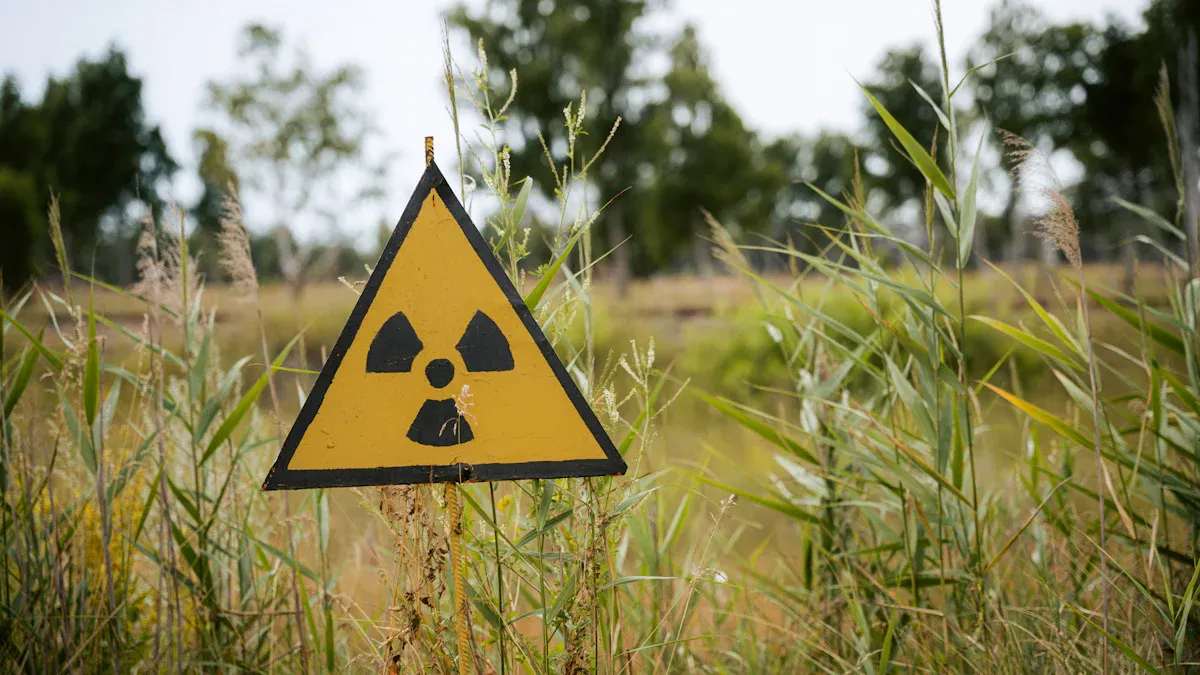Does Radiation Therapy Make You Radioactive

Radiation therapy does not always make you radioactive. External radiation therapy, such as teletherapy, uses high-energy beams to target cancer cells without leaving any residual radiation in your body, which means radiation therapy always makes you radioactive? is a misconception. You can safely interact with others, including hugging or kissing, after this treatment. Internal radiation therapy, on the other hand, may cause your body to emit small amounts of radiation temporarily. For example, patients with temporary implants might need to limit contact with others, especially pregnant women and children, until the implants are removed. Understanding these differences can help you feel more confident about your treatment.
Key Takeaways
External radiation therapy will not make you radioactive. You can be around others right after treatment safely.
Internal radiation therapy might make you temporarily radioactive. Follow your care team's rules to keep others safe during this time.
Knowing the difference between external and internal radiation therapy can help ease fears and clear up wrong ideas about safety.
Talk openly with your care team. They give advice and support about your treatment and safety.
Follow safety steps after internal radiation therapy. These steps keep your loved ones safe while you heal.
Radiation Therapy Always Makes You Radioactive?
You might wonder if radiation therapy always makes you radioactive. The answer depends on the type of therapy you receive. External radiation therapy does not make you radioactive, while internal radiation therapy might cause temporary radioactivity. Let’s explore these differences to help you understand your treatment better.
Why External Radiation Therapy Does Not Make You Radioactive
External radiation therapy uses high-energy beams to target cancer cells from outside your body. The radiation source remains external, so it does not stay in your body after treatment. This means you are not radioactive during or after the procedure. Studies confirm that external beam radiotherapy only affects cells momentarily, leaving no residual radiation behind. Since the radiation source never enters your body, you can safely interact with others immediately after your session.
When Internal Radiation Therapy Might Make You Radioactive
Internal radiation therapy involves placing a radiation source inside your body. This can make you temporarily radioactive because the treatment uses radionuclides that emit ionizing radiation. These radionuclides vary based on their decay properties, such as beta-particle or alpha-particle emitters. The choice of radionuclide depends on factors like its half-life and how it behaves in the body. Patients receiving radioactive implants or medications may emit small amounts of radiation for days or even months. However, doctors ensure it is safe before discharging you from the hospital.
Key Differences Between External and Internal Radiation Therapy
Understanding the differences between external and internal radiation therapy can clarify why one might make you radioactive while the other does not. Here’s a comparison:
Aspect | External Radiation Therapy | Internal Radiation Therapy |
|---|---|---|
Type of Radiation | Photons | Particulate radiation |
Mechanism | External beam delivery | Internal delivery via radiopharmaceuticals |
Targeting | Less targeted, affects surrounding tissues | Highly targeted, focuses on tumor cells |
Emission Types | Photons | Beta, alpha, and Auger electron emitters |
Clinical Applications | General cancer treatment | Specific cancers like thyroid or prostate |
Imaging Techniques | Not typically used for targeting | Uses SPECT and PET for imaging and dose calculation |
By understanding these distinctions, you can feel more informed and reassured about your treatment.
External Radiation Therapy and Radioactivity

How External Radiation Therapy Works
External radiation therapy targets cancer cells using high-energy beams from outside your body. The process focuses on delivering radiation to the tumor while sparing as much healthy tissue as possible. This method ensures that the radiation only interacts with the cells momentarily. Since no radioactive material enters your body, you do not retain any radioactivity after the treatment. This makes external radiation therapy a safe and effective option for many patients.
Why Radiation Does Not Stay in the Body
Radiation used in external therapy does not linger in your body. Once the treatment beam is turned off, the radiation stops affecting your cells. You can safely interact with others immediately after your session. Activities like hugging, kissing, or even sexual relations pose no risk to your loved ones. Unlike internal radiation therapy, which may involve radioactive materials, external therapy leaves no residual radiation behind. This distinction helps dispel the misconception that radiation therapy always makes you radioactive.
Common Misconceptions About External Radiation Therapy
Myth: Radiation treatment will make you radioactive, so you must avoid others.
Truth: This is not true for external radiation therapy. The radiation does not remain in your body after the treatment. You only need to take precautions if your therapy involves radioactive implants or medications, which your doctor will explain beforehand.
Understanding these facts can help you feel more confident about your treatment. External radiation therapy allows you to continue your daily life without worrying about exposing others to radiation.
Internal Radiation Therapy and Temporary Radioactivity

How Internal Radiation Therapy Works
Internal radiation therapy delivers radiation directly to cancer cells by placing a radioactive source inside your body. This method ensures precise targeting of tumors while minimizing damage to surrounding healthy tissues. The process involves several steps:
Step | Description |
|---|---|
1 | Selection of radionuclide based on its properties, production, and behavior. |
2 | Delivery of radionuclides to cancer cells through methods like endoradiotherapy. |
3 | Careful treatment planning to maximize effectiveness and reduce side effects. |
Brachytherapy (Radioactive Implants)
Brachytherapy involves placing small radioactive implants, such as seeds or pellets, near or inside the tumor. These implants emit radiation over a specific period, targeting cancer cells directly. Temporary implants are removed after treatment, while permanent ones lose their radioactivity gradually. During treatment, you may need to stay in the hospital and limit visitors to reduce exposure risks.
Systemic Radiation (Radioactive Medications)
Systemic radiation uses radioactive medications, often taken orally or injected, to treat cancer. These medications travel through your bloodstream, targeting cancer cells throughout your body. Depending on the type of radionuclide used, you might emit small amounts of radiation temporarily. Your care team will provide specific instructions to ensure safety during this period.
When You Might Be Radioactive After Treatment
After internal radiation therapy, your body may emit low levels of radiation for a short time. The duration depends on factors like the type of radionuclide, its half-life, and how your body excretes it. For example:
Low-energy beta emitters may not be detectable, while gamma emitters can produce noticeable radiation.
Temporary implants emit radiation only while in place, while permanent implants gradually lose their potency.
Your doctor will monitor these factors and guide you on when it’s safe to resume normal activities.
Precautions to Take After Internal Radiation Therapy
Limiting Contact With Others
To protect others, especially vulnerable individuals, you may need to limit close contact for a few days. Avoid prolonged physical interactions, such as hugging or sitting close, particularly with pregnant women and children. Your care team may also recommend staying in a private room during hospital treatment.
Special Considerations for Pregnant Women and Children
Pregnant women and young children are more sensitive to radiation. If you’ve received internal radiation therapy, avoid close contact with them until your doctor confirms it’s safe. Nursing mothers should stop breastfeeding temporarily if radioactive materials, like iodine-131, are used. These precautions help reduce risks and ensure the safety of your loved ones.
Tip: Follow all guidelines provided by your care team to minimize risks and feel confident about your recovery.
Addressing Misconceptions About Radiation Therapy
Myth: Radiation Therapy Always Makes You Radioactive
You might have heard the misconception that radiation therapy always makes you radioactive. This is not true for most treatments. External beam radiation therapy, for example, does not leave any residual radiation in your body. Once the treatment session ends, the radiation stops affecting your cells. You can safely interact with others, including children and pets, immediately after your session.
However, internal radiation therapy, such as brachytherapy or systemic radiation, may temporarily make you emit small amounts of radiation. This happens because radioactive materials are placed inside your body or introduced through medication. Even in these cases, your care team will provide clear instructions to ensure safety for you and those around you.
Myth: Radiation Therapy Is Dangerous to Others
Another common myth is that radiation therapy poses a danger to those around you. This is not true for external radiation therapy. The radiation used in these treatments does not linger in your body, so you cannot transmit it to others. Patients undergoing internal radiation therapy may need to take precautions, such as limiting close contact, but these measures are temporary and specific to the type of treatment.
Myth | Fact |
|---|---|
Radiation therapy is dangerous to others. | External radiation therapy does not make you radioactive. Internal therapy may require temporary precautions. |
Myth: Physical Contact Should Be Avoided After Treatment
Some people believe they must avoid physical contact after radiation therapy. This is only necessary in specific cases. For external radiation therapy, you can hug, kiss, or spend time with loved ones without any risk. Internal radiation therapy may require you to limit close contact for a short period, especially with pregnant women and children. Your doctor will guide you on when it’s safe to resume normal interactions.
Note: Always follow your care team’s advice to ensure safety and peace of mind.
Staying Safe and Informed
Communicating With Your Care Team
Your care team plays a vital role in ensuring your safety during and after radiation therapy. They provide personalized advice based on your treatment type. Always ask questions if you feel uncertain about any aspect of your care. For example, you might ask how long you need to follow specific precautions or when it’s safe to resume normal activities. Open communication helps you stay informed and confident about your recovery process.
It’s also important to share any changes in your health with your care team. Symptoms like unusual fatigue or discomfort could indicate the need for adjustments in your care plan. By staying in touch, you ensure that your treatment remains effective and safe.
Following Personalized Safety Guidelines
After internal radiation therapy, you may need to follow specific safety measures to protect others. These guidelines are designed to minimize exposure to radiation while your body processes the treatment. Common recommendations include:
Sit while using the toilet to prevent splashing.
Flush the toilet twice after each use and wash your hands thoroughly.
Use separate utensils and towels.
Drink extra fluids to help flush radioactive material from your body.
Avoid close contact with others, especially infants, children, and pregnant women.
Sleep in a separate bed and maintain a safe distance from others for a few days.
These steps may seem inconvenient, but they are temporary and ensure the safety of everyone around you.
Reassurance for Family and Friends
Radiation therapy often raises concerns among loved ones. Understanding the safety of different treatments can ease their worries. External beam radiation therapy does not leave any radiation in your body, so it is safe to be around others immediately after treatment. Internal or systemic radiation therapy may require temporary precautions, but these are carefully managed by your care team.
Type of Radiation Therapy | Safety for Family and Friends |
|---|---|
External Beam Radiation Therapy | No radiation in the body, safe at all times |
Internal/Systemic Radiation | Can emit radiation temporarily, caution needed |
Reassure your family and friends by sharing this information. Let them know that your care team has taken every precaution to ensure their safety. This understanding can help them feel more comfortable supporting you during your recovery.
External radiation therapy does not make you radioactive. You can safely interact with others immediately after treatment. Internal radiation therapy, however, may cause temporary radioactivity. Following safety precautions, like limiting close contact, helps protect those around you.
Tip: Always consult your care team for personalized advice. They can guide you on precautions and answer any concerns.
Understanding your treatment empowers you to feel confident and at ease. By staying informed, you can focus on recovery while ensuring the safety of yourself and your loved ones.
FAQ
Does radiation therapy hurt during treatment?
Radiation therapy itself is painless. You might feel discomfort from lying still or from the equipment setup. Over time, side effects like skin irritation or fatigue may develop. Your care team will help manage these symptoms to keep you comfortable.
Can I go to work during radiation therapy?
Yes, many people continue working during radiation therapy. However, you might feel tired as treatment progresses. Adjust your schedule based on how you feel. Discuss your workload with your employer and consider taking breaks when needed.
Is it safe to be around pets after radiation therapy?
External radiation therapy is safe for pets. Internal radiation therapy might require temporary precautions. Avoid close contact with pets if your doctor advises it. Follow specific guidelines to ensure their safety and yours.
How long do side effects from radiation therapy last?
Side effects vary by person and treatment type. Some, like fatigue or skin changes, may last a few weeks after treatment ends. Others, like tissue changes, could take longer. Your care team will guide you on managing and monitoring these effects.
Can I exercise during radiation therapy?
Light exercise, like walking or yoga, is usually safe and can help reduce fatigue. Avoid strenuous activities if you feel tired. Always consult your doctor before starting or continuing an exercise routine during treatment.
Tip: Listen to your body and rest when needed. Staying active can support your recovery.
See Also
Understanding Carcinoid Tumors: Essential Information You Need
Simplifying The Causes Of Gastrointestinal Stromal Tumors
Treatment Options For Acute Myeloid Dendritic Cell Leukemia
